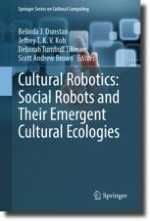This edited collection approaches the field of social robotics from the perspective of a cultural ecology, fostering a deeper examination of the reach of robotic technology into the lived experience of diverse human populations, as well as the impact of human cultures on the development and design of these social agents.
To address the broad topic of Cultural Robotics, the book is sectioned into three focus areas: Human Futures, Assistive Technologies, and Creative Platforms and their Communities. The Human Futures section includes chapters on the histories and future of social robot morphology design, sensory and sonic interaction with robots, technology ethics, material explorations of embodiment, and robotic performed sentience. The Assistive Technologies section presents chapters from community-led teams, and researchers working to adopt a strengths-based approach to designing assistive technologies for those with disability or neurodivergence. Importantly, this section contains work written by authors belonging to those communities. Creative Platforms and their Communities looks to the creative cross-disciplinary researchers adopting robotics within their art practices, those contributing creatively to more traditional robotics research, and the testing of robotics in non-traditional platforms such as museum and gallery spaces.
Cultural Robotics: Social Robots and their Emergent Cultural Ecologies makes a case for the development of social robotics to be increasingly informed by community-led transdisciplinary research, to be decentralised and democratised, shaped by teams with a diversity of backgrounds, informed by both experts and non-experts, and tested in both traditional and non-traditional platforms. In this way, the field of cultural robotics as an ecological approach to encompassing the widest possible spectrum of human experience in the development of social robotics can be advanced.
